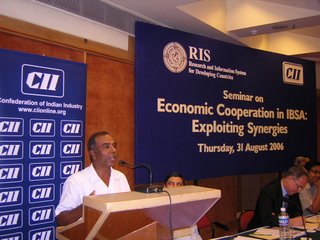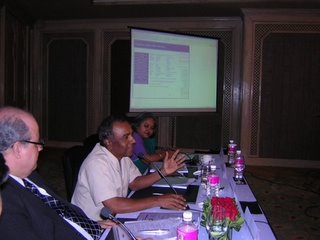
Punta Arenas in Chile is the southern-most city in the world close to Antarctica. I was there in April 2005 with a delegation. When I was cruising in the Magellan straits, reflecting on its maritime history, a thought struck me about my own. How did I reach Punta Arenas and from where ? How did a poor country kid reach the farthest part of the world!. The answer was Poondi Pushpam College. It proved to be my magic carpet. Not having travelled beyond Trichy and Thanjavur until the age of twenty, I had dreamt of non-stop journey to the farthest corners of the world. That dream for distant destinations materialised because the Pushpam college was so near. If there was no college in Poondi, I would not have become a globe-trotting diplomat, visiting exotic places like Punta Arenas.
Another trip which made me to look back at my root was the trip upstream in the river Orinoco to Colombia in the Amazon region in 2003. It was like a journey from ‘Malgudi’ to ‘Maconde’. R.K Narayan’s imaginary Indian town of Malgudi embodies the value system of simple folk pursuing traditional life. My place of birth, Alangudi Mahajanam, is close to Lalgudi, which is almost like Malgudi.
On the other hand, Maconde is the mythical town in the novel “One Hundred Years of Solitude” by the Colombian Nobel-laureate Gabriel Garcia Marquez. The spirit of Maconde is ‘Magical realism’, the literary genre, popular in Latin America. Malgudi and Maconde are contrasting in cultures. Salsa and Samba, Carnival and Football, Beaches and Bikinis, fun and enjoyment are Latin American cultural manifestations. In contrast, Malgudi culture is simple living and self-denial of comfort, enjoyment and wealth. While the old Indian renounces life and looks at Kasi or the Himalayas as his next and final destination, the Latin American does not give up. He sings
“We don’t stop having fun when we grow old
We grow old only when we stop having fun.”
Latin America has become my passion. I feel at home in the beaches of Copacabana and bars of Ipanema. I am fascinated by the Latin American literature and culture. I follow avidly the political and economic developments of the region. I express my emotions and feelings spontaneously in Spanish and Portuguese. Brazil beckons me, (in Portuguese)
Amor da minha vida, luz de meu querer
Vem..vem fica comigo
Sou quem sou ... so por voce
Means
Love of my life, light of love
Come.. come to be with me
I am what I am … just for you
The loud Latin America murmurs softly in the ears of this quiet and introspective Indian,
Quisera oir tu silencio
Quisera callar mis palabras
This poem (Spanish) means
I want to listen to your silence
I wish to silence my words
Every time I visit Raramuthiraikottai, the village three kiolmeters west of Poondi, I heave a sigh of relief. In this village, where I spent my life from the age of four to twenty, most of my schoolmates are still mired in poverty struggling with subsistent agriculture. I was lucky to escape and join the diplomatic glitterati and move seamlessly between the worlds of “Cheers!” and “Your Excellency”
My uncle who brought me up did not believe that education would lead to a viable livelihood. He would, therefore, ask me to stop the studies at the beginning of every summer holidays of school. I managed to finish the schooling in the Government Higher Secondary School in Mariammankovil. After this, my uncle put his foot down and said with a finality in his voice, “ Enough of your studies. We cannot afford to send you to college. Get ready to look after the land and cattle” That is when, Poondi College came to my rescue. I told him that the college was just three kms from the village. I promised to him that I would do the farm work in the morning and during weekend. I convinced him that the amount of scholarship I would get with my high marks would be more than the college fees. Reluctantly, he agreed. And my escape thereafter, was unstoppable.
If there was no college in Poondi, I would have still been cutting grass for the cattle on the side of the railroad, waving to to the passengers of Thanjavur and Nagore train.I was reminded of my grass cutting work in a rather jealous way, when I found in Brazil that each cow has eight hectares of land to graze in this large and lucky country. Reference to cows leads me to another incident. A Brazilian friend pulled my leg in a Steak restaurant saying that I was not to touch beef as a Hindu. I told him he was perfectly right since the Indian cows are sacred, but the Brasilian cows are not.
I am delighted to see that the college has grown bigger and added more courses and has started giving opportunities even for girls. My greatest thrill now is to see my niece Anita from the same village going to the same college. If not for this college, her mother would not have allowed her to go to distant places. The only difference between me and my niece is that I had to walk to the college while she has the luxury of going by cycle. But walking proved to be a blessing for me. I could review my lessons twice a day during the walk to the college and back.
The second advantage of the college was that since many students were from similar rural background and from Tamil medium schools, I was in the comfort zone. Later when I went to Chennai for higher studies and Delhi for joining the Foreign Service I was intimidated by the high-flying rich kids with Don Bosco and Doon School accents. It took a while for me to overcome this challenge, regain confidence and eventually beat many of them in show as well as substance. I was more hungry to catch up and prove myself.
I take this opportunity to express my profound gratitude to the founders of the college and the visionary Thiru Tulasi Ayya Vandayar, with whom I had the opportunity to interact and get inspired a few times. I am also grateful to the faculty of the college and especially Chemistry professor Srinivasan and Tamil professor Kannaiyan, who inspired me to aspire.
My best wishes for the success of the college and its noble role as the hope and promise for the rural youth around Poondi.
-------------------------------------------------------------------------------------
This article was written for the magazine of the College on the occasion of Golden jubilee celebrations in 2006.
___________________________________________________________________________














